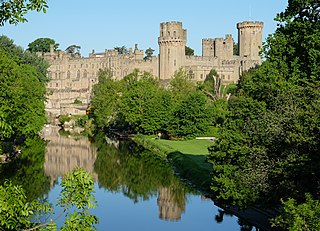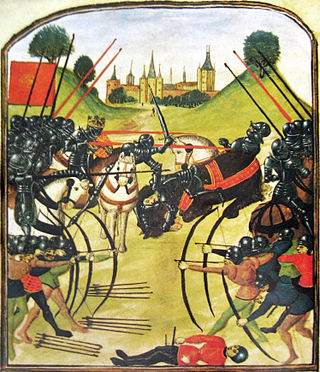
A rapier or espada ropera is a type of sword with a slender and sharply pointed two-edged blade that was popular in Western Europe, both for civilian use and as a military side arm, throughout the 16th and 17th centuries.
The spatha was a type of straight and long sword, measuring between 0.5 and 1 m, with a handle length of between 18 and 20 cm, in use in the territory of the Roman Empire during the 1st to 6th centuries AD. Later swords, from the 7th to 10th centuries, like the Viking swords, are recognizable derivatives and sometimes subsumed under the term spatha.

Warwick Castle is a medieval castle developed from a wooden fort, originally built by William the Conqueror during 1068. Warwick is the county town of Warwickshire, England, situated on a meander of the River Avon. The original wooden motte-and-bailey castle was rebuilt in stone during the 12th century. During the Hundred Years War, the facade opposite the town was refortified, resulting in one of the most recognisable examples of 14th-century military architecture. It was used as a stronghold until the early 17th century, when it was granted to Sir Fulke Greville by James I in 1604. Greville converted it to a country house, and it was owned by the Greville family until 1978, when it was bought by the Tussauds Group.

Warwick is a market town, civil parish and the county town of Warwickshire in the Warwick District in England, adjacent to the River Avon. It is 9 miles (14 km) south of Coventry, and 19 miles (31 km) south-east of Birmingham. It is adjoined with Leamington Spa and Whitnash.

Earl of Warwick is one of the most prestigious titles in the peerages of the United Kingdom. The title has been created four times in English history, and the name refers to Warwick Castle and the town of Warwick.

Guy de Beauchamp, 10th Earl of Warwick was an English magnate, and one of the principal opponents of King Edward II and his favourite, Piers Gaveston. Guy was the son of William de Beauchamp, the first Beauchamp earl of Warwick, and succeeded his father in 1298. He distinguished himself at the Battle of Falkirk and subsequently, as a capable servant of the crown under King Edward I. After the succession of Edward II in 1307, however, he soon fell out with the new king and the king's favourite, Piers Gaveston. Warwick was one of the main architects behind the Ordinances of 1311, that limited the powers of the king and banished Gaveston into exile.

Thomas de Beauchamp, 11th Earl of Warwick, KG, sometimes styled as Lord Warwick, was an English nobleman and military commander during the Hundred Years' War. His reputation as a military leader was so formidable that he was nicknamed 'the devil Warwick' by the French. In 1348 he became one of the founders and the third Knight of the Order of the Garter.

Swordsmanship or sword fighting refers to the skills and techniques used in combat and training with any type of sword. The term is modern, and as such was mainly used to refer to smallsword fencing, but by extension it can also be applied to any martial art involving the use of a sword. The formation of the English word "swordsman" is parallel to the Latin word gladiator, a term for the professional fighters who fought against each other and a variety of other foes for the entertainment of spectators in the Roman Empire. The word gladiator itself comes from the Latin word gladius, which is a type of sword.

Guy of Warwick, or Gui de Warewic, is a legendary English hero of Romance popular in England and France from the 13th to 17th centuries. The story of Sir Guy is considered by scholars to be part of the Matter of England.

Leek Wootton is a village and former civil parish, now in the parish of Leek Wootton and Guy's Cliffe, in the Warwick district, in the county of Warwickshire, England, approximately 2 miles south of Kenilworth and 2.5 miles north of Warwick. It lies in the triangle created by Kenilworth, Warwick and Leamington Spa. In 1961 the parish had a population of 671.

A glaive is a European polearm, consisting of a single-edged blade on the end of a pole. It is similar to the war scythe, the Japanese naginata, the Chinese guandao, the Korean woldo, and the Russian sovnya.

Joyeuse was, in medieval legend, the sword wielded by Charlemagne as his personal weapon. A sword identified as Joyeuse was used in French royal coronation ceremonies since the 13th century, and is now kept at the Louvre museum.

The term Italian school of swordsmanship is used to describe the Italian style of fencing and edged-weapon combat from the time of the first extant Italian swordsmanship treatise (1409) to the days of Classical Fencing.

Warwick School is a selective, public school in Warwick, England.

Waleran de Beaumont, 4th Earl of Warwick was the second son of Earl Roger of Warwick and Gundreda de Warenne, daughter of William de Warenne, 2nd Earl of Surrey and Elizabeth de Vermandois. He was known in his elder brother's time as 'Waleran of Warwick' marking the shift of surname in the family in his generation. The surnames 'Beaumont' and 'Newburgh' were used by the first two generations of the family, and are applied to the later generations by convention.

Guy's Cliffe is a hamlet and former civil parish on the River Avon and the Coventry Road between Warwick and Leek Wootton, in the parish of Leek Wootton and Guy's Cliffe, in the Warwick district, in Warwickshire, England, near Old Milverton. In 1961 the parish had a population of 2.

The Wars of the Roses (1455–1487), known at the time and for more than a century after as the Civil Wars, were a series of civil wars fought over control of the English throne in the mid- to late fifteenth century. These wars were fought between supporters of two rival cadet branches of the royal House of Plantagenet: Lancaster and York. The wars extinguished the last male line of the house of Lancaster in 1471, leading to the Tudor family inheriting the Lancastrian claim to the throne. Following the war and the extinction of the last male line of the house of York in 1483, a politically arranged marriage united the Houses of Tudor and York, creating a new royal dynasty which inherited the Yorkist claim as well, thereby resolving the conflict.

The Sword of Monte Cristo is a 1951 American adventure film written and directed by Maurice Geraghty. The film stars George Montgomery, Rita Corday, Berry Kroeger, William Conrad, Rhys Williams and Steve Brodie. It is loosely based on the 1844 novel The Count of Monte Cristo by Alexandre Dumas. The film was released on March 3, 1951, by 20th Century Fox.

Colbrand was a legendary giant from English folklore, supposedly defeated by Guy of Warwick, a legendary English hero of Romance popular in England and France from the 13th to 17th centuries. The story of Sir Guy is considered by scholars to be part of the Matter of England. According to the story, Guy returned to England after some years of absence to deliver Winchester for Athelstan of England from the invading northern kings, Anelaph and Gonelaph, by slaying in single combat their champion, the Danish giant Colbrand.

















